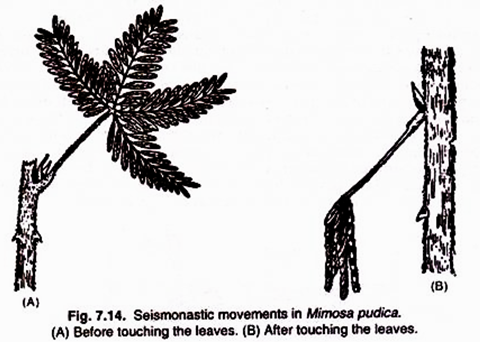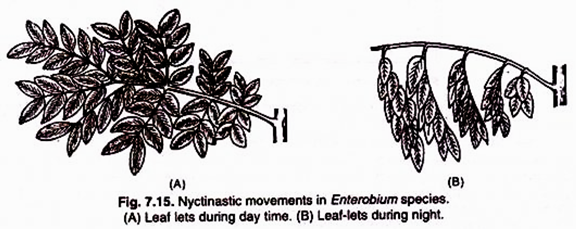ADVERTISEMENTS:
The below mentioned article will highlight the four types of nastic movements in plants.
The four types are: (1) Seismonastic Movements (2) Photonastic Movements (3) Thermonastic Movements and (4) Nyctinastic Movements.
Type # 1. Seismonastic Movements:
These movements are brought about by mechanical stimuli such as contact with a foreign body, fast wind and rain drops etc. Seismonastic movements are seen in stigmas, stamens and leaves of many plants. For instance, movements of leaf lets in Mimosa pudica (Sensitive plant, Fig. 7.14), Biophytum sensitivum and Neptunia, etc.
Stigma lobes in certain plants such as Mimulus, Martynia and Bignonia, etc., encircle the pollengram as soon as it falls over them Stamens of Berberis, Portulaca and Opuntia respond instantly when touched by the body to any insect. The extent of the seismonastic movement depends upon such factors as the intensity of the stimulus, the vigour and age of the plant, and the time elapsed since the last stimulus.
Type # 2. Photonastic Movements:
These movements are induced by fluctuations in the intensity of light Such movements are exhibited by flowers of several plants. Many flowers open with the increasing illumination of the day and close up with the decrease in light intensity. Flowers of Cestrum nocturnum open at night, and close up with the dawn of the day.
Type # 3. Thermonastic Movements:
Such movements are brought about by changes in temperature. Many of the flower movements are thermonastic. Such flowers open with a rise and close with a drop in temperature. Sometimes thermonastic movements are associated with photonastic movements. In both types of responses the mechanism may be either differential growth, or changes in turgor on upper and lower sides of the petiole, leaf blade, or perianth part.
Type # 4. Nyctinastic Movements:
These movements are commonly called ‘sleeping movements’. Some authors have classified such movements under the category of photonastic or thermonastic movements. These movements are induced by alternation of day and night. The leaves of some plants like Enterobium (Fig. 7.15), clover and oxalis, growing approximately horizontal during the day, begin to droop and close toward evening and do not rise again until the next morning.
Conclusion:
Various kinds of movements are exhibited by plants and their organs. Smaller plant organisms and naked protoplasmic bodies show movements of locomotion where as higher plants, being fixed in a position, show movements of curvature. All such movements may be tactic, tropic or nastic.

